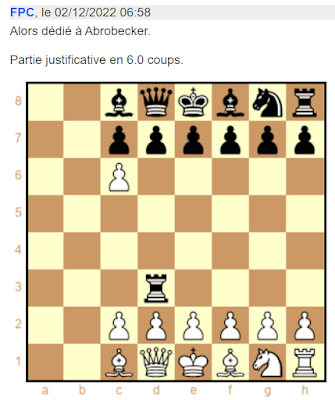Chess problems with initials
From the starting position of an orthodox chess game, we will try today to empty some columns of their pieces – and this as quickly as possible.
We will try for example to empty below the columns a and e (these are the initials of the author and his father).
Is it possible to use less than the 13 plies shown hereunder? (ply is demi-coup in French)
We will try for example to empty below the columns a and e (these are the initials of the author and his father).
Is it possible to use less than the 13 plies shown hereunder? (ply is demi-coup in French)
(1) a3–e5
(2) d4–Bxa
(3) Kd2–Bxb
(4) Rxa—exd
(6) RxN—Kf8
Columns a and e are now empty
This idea was first submitted to the France Échecs chess forum on November the 28th around midnight – see here.
My sister and my daughter have initials a and c. My brother a and d.
Would you give them a try?
Send your answers to eric dot angelini at skynet dot com (if you want).
Best,
É.
____________________
Update, November 30th 2022
For my daughter C. and for my sister, we need, I guess, at least 14 plies to clear the columns a and c:
End position with the empty columns a and c
1. a4—b5
2. axb—Bb7
3. Rxa—RxR
4. c4—Ra2
5. c5—Rxb
6. BxR—d6
7. cxd—cxd
For my brother D., hereunder, we need at least 13 plies to clear the columns a and d:
End position with the empty columns a and d
1. d4–c5
2. dxc—e5
3. Qxe—QxQ
4. Nc3—Qxa
5. RxQ—Nc6
6. Rxa—Rb8
7. Rxb
I’m going to face Daniel B. and Bernard G. in tennis tonight: I will offer them the challenges d + b and b + g!
Best,
É.
(to be continued?)
____________________
Well, yes – with this (France-Échecs) – click on the diagram to enlarge:
Shortest proof game in 7.0 moves
... and this :
Shortest proof game in 6.0 moves
... perhaps more in a couple of days (yes — see below)
_________________________
Note:
My Australian math friend Scott S. wrote to me this morning:
> P.-S. your least number of moves to clear the chess columns is really nice! This could actually be a sequence… n=1...8 for each of the 8 columns. Not sure how one could prove the minimal numbers except for maybe programming Stockfish, etc. to do an exhaustive search, which would probably be possible given its relatively few moves.
> Of course when looking at this I was stuck by a much, much more difficult question… minimum number of moves so that all the white non-pawn pieces are on the starting square of the corresponding black piece. That’s one question. Second one is both the white *and* black non-pawn pieces to be on the starting square of their opposite colored piece!
> Considering the later, we can work out an (impossible) minimum… it takes 3 plies for each rook to reach the opposite corner (12 plies for all four rooks… that’s true if the rooks move to the diagonally opposite corner or the directly opposite one), it takes 4 plies for each knight (goes diagonally across)… (16 plies for all four), 2 plies for each bishop (8 plies in all), 1 ply for one queen but 3 for the other (4 in all), 7 plies for each king (14 in all). So that’s…. 54 plies. But…. The damned pawns get in the way. Figuring out the min number of pawn moves to clear the paths is hard. I think with all the pawns removed it could be done in 54 though…. But as one queen gets there in 1 while other in 3 would one queen have to waste a ply? Maybe its 55 then. But anyway nice puzzle when pawns are also present, but that’s then a really hard question it seems.
Thanks, Scott!
_________________________



















Commentaires
Enregistrer un commentaire